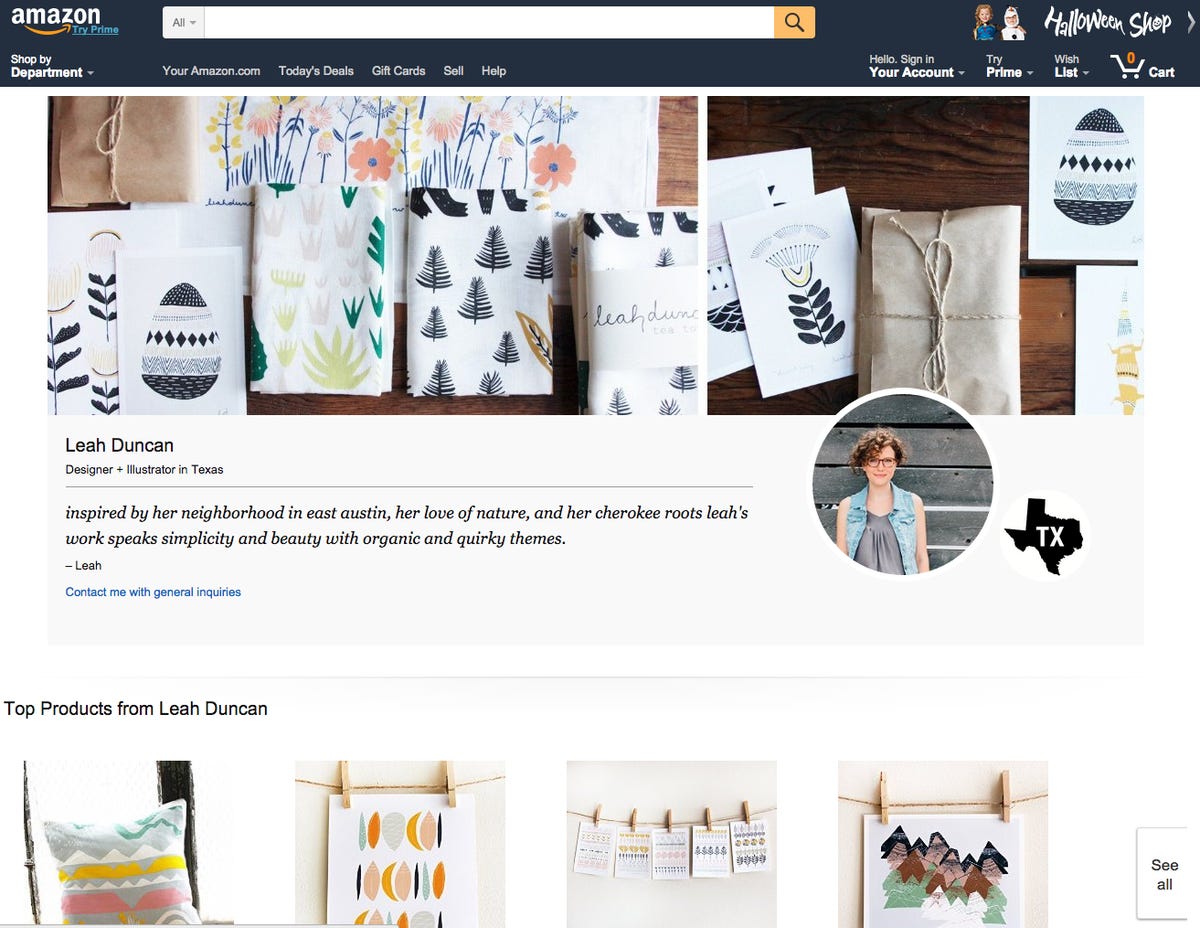Amazon already sells tens of millions of products. Why not a handmade, reclaimed-wood coffee table that doubles as a wine rack?
With that in mind, the Seattle-based company on Thursday launched Handmade at Amazon, a specialized storefront that promotes only handcrafted goods and the artisans who create them, a market now dominated by much smaller e-retailer Etsy. The program will start with over 5,000 artists, most from the US, and more than 80,000 listings of artwork, jewelry and other items. Handmade will only be available on the main Amazon.com site.
“We’re entering this space because our customers have told us that they want it,” said April Lane, Amazon’s category leader for Handmade. “We get thousands of searches every day for handmade items.”

Amazon
Beyond Amazon’s typical fare of Legos, Blu-ray discs, paperbacks and diapers, customers will now be able to shop for beaded bracelets from Ghana and art prints from Austin.
Handmade serves as yet another example of Amazon’s outsized ambitions to be the everything store for everybody, and adopting any successful e-commerce model it sees along the way. The company already sells millions of mass-produced products, and it has started to focus on niche areas so it can keep expanding its inventory. The world’s largest e-commerce company by sales opened two other online stores this year, Amazon Launchpad and Amazon Exclusives, which both highlight products from small, up-and-coming companies. It is also branched into services, such as its Home Services marketplace for hiring a plumber or painter that’s become a new competitor to Angie’s List.
Amazon’s push into handmade items creates a major headache for Etsy, a specialty marketplace focused on artists’ wares. Etsy’s stock has been in decline since it went public in April, as the company has been accused of failing to control counterfeit sales on its site. Amazon’s move into Etsy’s core business, which was first reported in May, has pushed down the Brooklyn, New York, company’s shares even further.
Amazon has been aggressively courting Etsy sellers, who could profit from access to Amazon’s roughly 280 million active shoppers, more than 10 times Etsy’s 21 million active buyers.

 Enlarge Image
Enlarge ImageAmazon
Etsy’s counterfeiting issue and its move to allow sellers to start mass-producing items have frustrated many Etsy artists, said Wedbush analyst Gil Luria. These artists didn’t have a sizable online alternative to Etsy, though.
“That all changes with Handmade at Amazon,” Luria said. “For Etsy, this is a big problem.”
Etsy argues that it has spent 10 years developing tools for artists to expand their businesses, including educational resources, information on craft fairs and a wholesale service to connect sellers to boutiques. In a July report, the company said that only about 0.5 percent of all its listings have been affected by intellectual property takedown notices and that it dedicates “substantial resources” to dealing with site violations.
Amazon said it plans to be more restrictive about the sellers it lets into Handmade. This may help Amazon avoid counterfeiting allegations.
“We believe we are the best platform for creative entrepreneurs, empowering them to succeed on their own terms,” Etsy CEO Chad Dickerson said in a statement. “Etsy has a decade of experience understanding the needs of artists and sellers and supporting them in ways that no other marketplace can.”
A new place for artists
Those artists include Michael Graham, a former high school science teacher who makes furniture such as credenzas and coffee tables out of reclaimed wooden grape boxes from his Los Angeles studio.
Graham, 41, has been selling items on Etsy for two years but jumped at the chance to join Handmade so he could put his wares in front of one of the largest buying audiences in the world.
“Many people haven’t heard of Etsy, but everyone’s heard of Amazon,” Graham said. “I think it’s going to be a game-changer.”


Amazon
Amazon’s roughly 15 percent commission (after a one-year, 12 percent promotion rate) is substantially higher than Etsy’s 3.5 percent cut, but Graham said it is worth it to reach Amazon’s larger customer base.
Darla Garfield, 37, who makes jewelry atop her dining table in New Plymouth, Idaho, is also excited to bring her goods to Amazon.
“I love the handmade idea, and just strictly handmade,” said Garfield, who sells her goods under the shop name Sheekydoodle. “That’s what made Etsy beautiful when I joined five years ago.”
Both artists plan to continue selling on Etsy.
While Etsy’s business has been growing fast, the company brought in only $196 million in revenue last year. That amount is tiny for Amazon, which reported sales of $89 billion last year.
Amazon’s marketplace business, which lets third-party retailers sell on its site for a commission, has become a major profit engine for the company, Wedbush’s Luria said. So any way Amazon can grow that business will benefit its bottom line.
Even though Amazon is often perceived as the big bad wolf in e-retail, Luria said he doesn’t expect any backlash from the artist community over Handmade.
“Not only will sellers accept this with open arms,” he said, “but so will buyers.”
Amazon’s Lane said Handmade is starting with just six categories: home, jewelry, artwork, stationery and party supplies, kitchen and dining, and baby. The immediate goal will be to expand into more categories, she said.
Most goods will be shipped directly by artists, but Amazon will use its massive logistics and warehouse infrastructure to ship about 700 items so far.
“The artisan response has been great,” Lane said, “so we’re excited to see how customers respond.”




